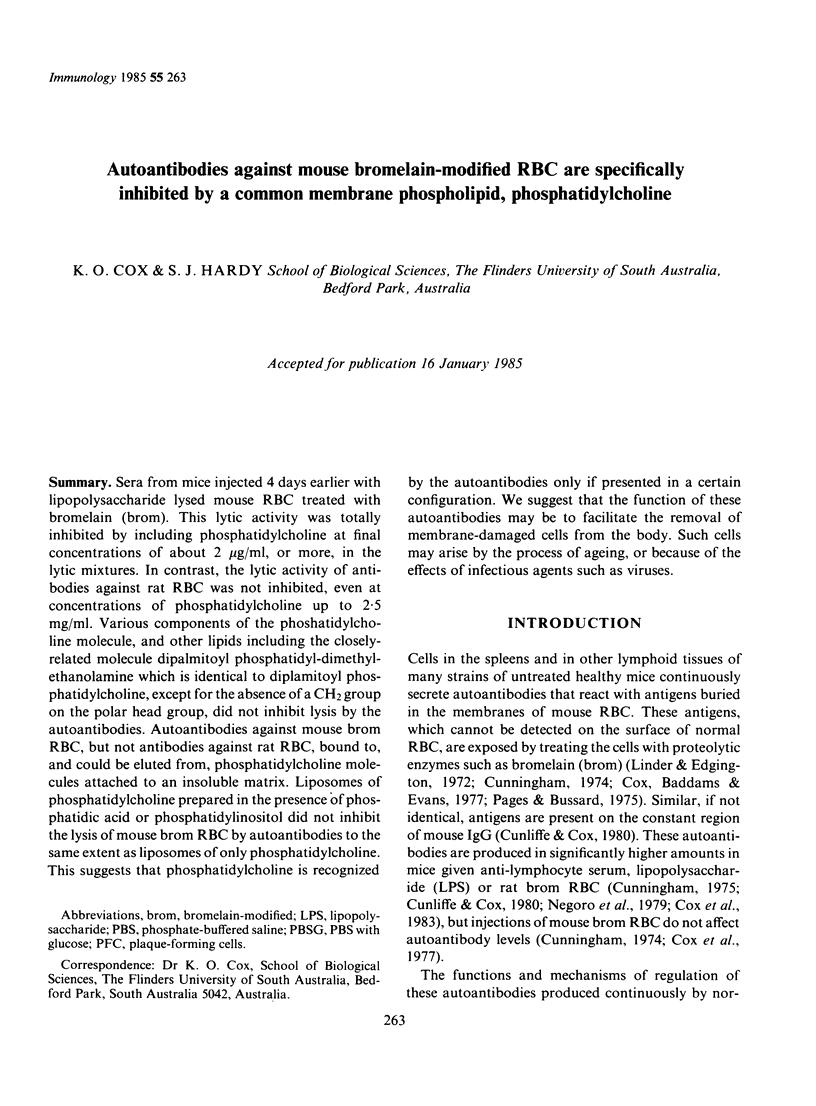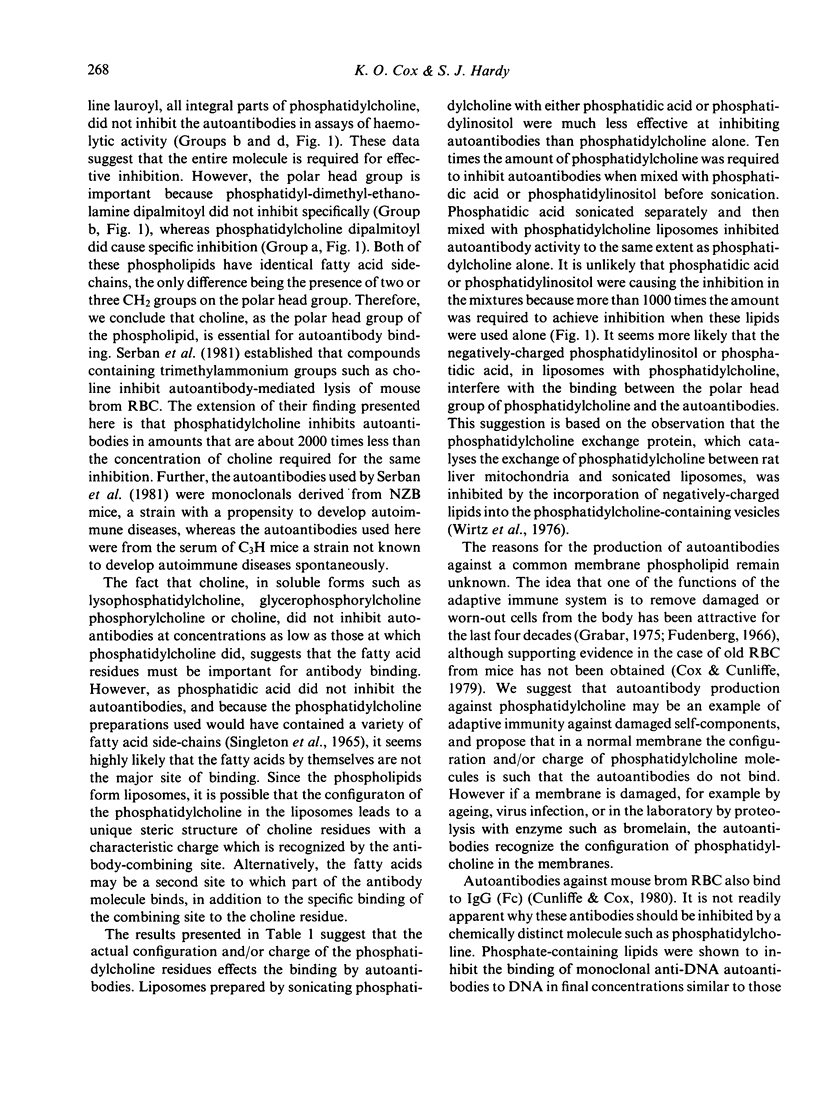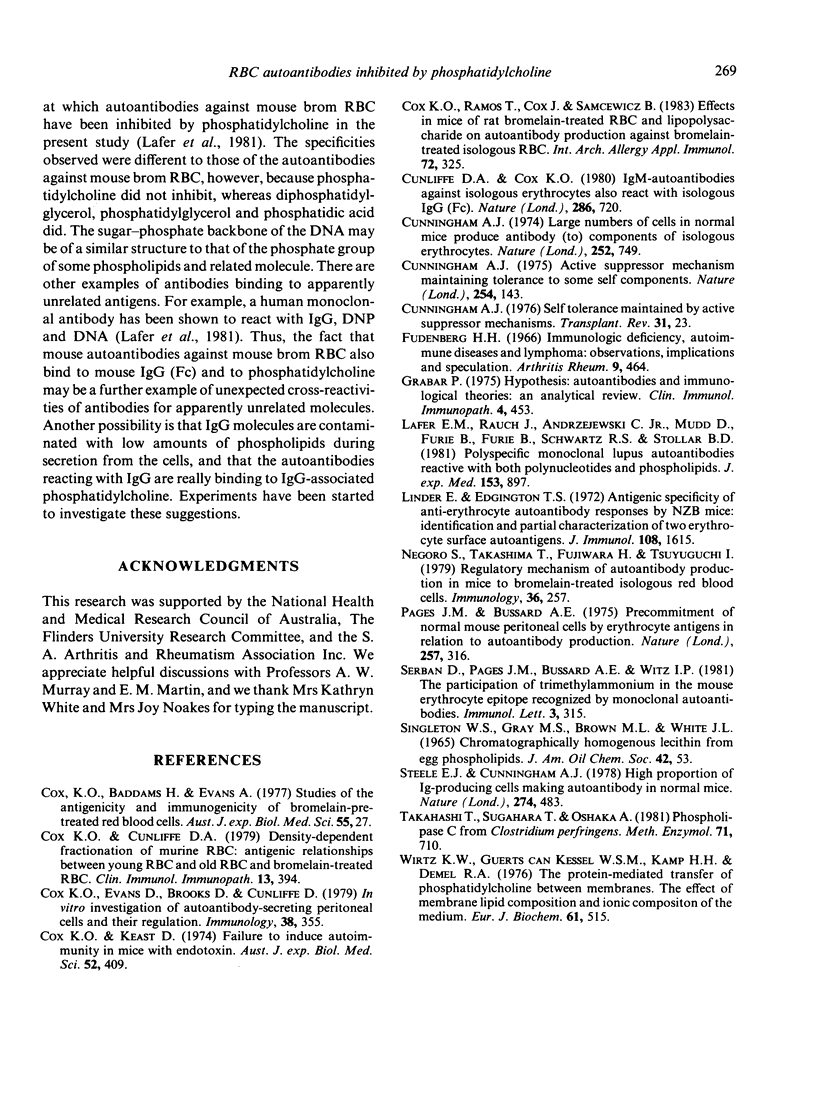Abstract
Sera from mice injected 4 days earlier with lipopolysaccharide lysed mouse RBC treated with bromelain (brom). This lytic activity was totally inhibited by including phosphatidylcholine at final concentrations of about 2 micrograms/ml, or more, in the lytic mixtures. In contrast, the lytic activity of antibodies against rat RBC was not inhibited, even at concentrations of phosphatidylcholine up to 2.5 mg/ml. Various components of the phosphatidylcholine molecule, and other lipids including the closely-related molecule dipalmitoyl phosphatidyl-dimethyl-ethanolamine which is identical to dipalmitoyl phosphatidylcholine, except for the absence of a CH2 group on the polar head group, did not inhibit lysis by the autoantibodies. Autoantibodies against mouse brom RBC, but not antibodies against rat RBC, bound to, and could be eluted from, phosphatidylcholine molecules attached to an insoluble matrix. Liposomes of phosphatidylcholine prepared in the presence of phosphatidic acid or phosphatidylinositol did not inhibit the lysis of mouse brom RBC by autoantibodies to the same extent as liposomes of only phosphatidylcholine. This suggests that phosphatidylcholine is recognized by the autoantibodies only if presented in a certain configuration. We suggest that the function of these autoantibodies may be to facilitate the removal of membrane-damaged cells from the body. Such cells may arise by the process of ageing, or because of the effects of infectious agents such as viruses.
Full text
PDF






Selected References
These references are in PubMed. This may not be the complete list of references from this article.
- Cox K. O., Baddams H., Evans A. Studies of the antigenicity and immunogenicity of bromelain-pretreated red blood cells. Aust J Exp Biol Med Sci. 1977 Feb;55(1):27–37. doi: 10.1038/icb.1977.3. [DOI] [PubMed] [Google Scholar]
- Cox K. O., Cunliffe D. A. Density-dependent fractionation of murine RBC: antigenic relationships between young RBC and old RBC and bromelain-treated RBC. Clin Immunol Immunopathol. 1979 Aug;13(4):394–401. doi: 10.1016/0090-1229(79)90080-1. [DOI] [PubMed] [Google Scholar]
- Cox K. O., Evans D., Brooks D., Cunliffe D. A. In vitro investigation of autoantibody-secreting peritoneal cells and their regulation. Immunology. 1979 Oct;38(2):355–365. [PMC free article] [PubMed] [Google Scholar]
- Cox K. O., Keast D. Failure to induce autoimmunity in mice with endotoxin. Aust J Exp Biol Med Sci. 1974 Apr;52(2):409–411. doi: 10.1038/icb.1974.40. [DOI] [PubMed] [Google Scholar]
- Cox K. O., Ramos T., Cox J., Samcewicz B. Effects in mice of rat bromelain-treated RBC and lipopolysaccharide on autoantibody production against bromelain-treated isologous RBC. Int Arch Allergy Appl Immunol. 1983;72(4):325–329. doi: 10.1159/000234891. [DOI] [PubMed] [Google Scholar]
- Cunliffe D. A., Cox K. O. IgM-autoantibodies against isologous erythrocytes also react with isologous IgG(Fc). Nature. 1980 Aug 14;286(5774):720–722. doi: 10.1038/286720a0. [DOI] [PubMed] [Google Scholar]
- Cunningham A. J. Active suppressor mechanism maintaining tolerance to some self components. Nature. 1975 Mar 13;254(5496):143–144. doi: 10.1038/254143a0. [DOI] [PubMed] [Google Scholar]
- Cunningham A. J. Large numbers of cells in normal mice produce antibody components of isologous erythrocytes. Nature. 1974 Dec 20;252(5485):749–751. doi: 10.1038/252749a0. [DOI] [PubMed] [Google Scholar]
- Cunningham A. J. Self-tolerance maintained by active suppressor mechanisms. Transplant Rev. 1976;31:23–43. doi: 10.1111/j.1600-065x.1976.tb01451.x. [DOI] [PubMed] [Google Scholar]
- Fudenberg H. H. Immunologic deficiency, autoimmune disease, and lymphoma: observations, implications, and speculations. Arthritis Rheum. 1966 Jun;9(3):464–472. doi: 10.1002/art.1780090310. [DOI] [PubMed] [Google Scholar]
- Grabar P. Hypothesis. Auto-antibodies and immunological theories: an analytical review. Clin Immunol Immunopathol. 1975 Nov;4(4):453–466. doi: 10.1016/0090-1229(75)90087-2. [DOI] [PubMed] [Google Scholar]
- Lafer E. M., Rauch J., Andrzejewski C., Jr, Mudd D., Furie B., Furie B., Schwartz R. S., Stollar B. D. Polyspecific monoclonal lupus autoantibodies reactive with both polynucleotides and phospholipids. J Exp Med. 1981 Apr 1;153(4):897–909. doi: 10.1084/jem.153.4.897. [DOI] [PMC free article] [PubMed] [Google Scholar]
- Negoro S., Takashima T., Fujiwara H., Tsuyuguchi I. Regulatory mechanism of autoantibody production in mice to bromelin-treated isologous red blood cells. Immunology. 1979 Feb;36(2):257–264. [PMC free article] [PubMed] [Google Scholar]
- Pages J., Bussard A. E. Precommitment of normal mouse peritoneal cells by erythrocyte antigens in relation to auto-antibody production. Nature. 1975 Sep 25;257(5524):316–317. doi: 10.1038/257316a0. [DOI] [PubMed] [Google Scholar]
- SINGLETON W. S., GRAY M. S., BROWN M. L., WHITE J. L. CHROMATOGRAPHICALLY HOMOGENEOUS LECITHIN FROM EGG PHOSPHOLIPIDS. J Am Oil Chem Soc. 1965 Jan;42:53–56. doi: 10.1007/BF02558256. [DOI] [PubMed] [Google Scholar]
- Serban D., Pages J. M., Bussard A. E., Witz I. P. The participation of trimethylammonium in the mouse erythrocyte epitope recognized by monoclonal autoantibodies. Immunol Lett. 1981 Nov;3(5):315–319. doi: 10.1016/0165-2478(81)90012-2. [DOI] [PubMed] [Google Scholar]
- Wirtz K. W., Van Kessel W. S., Kamp H. H., Demel R. A. The protein-mediated transfer of phosphatidylcholine between membranes. The effect of membrane lipid composition and ionic composition of the medium. Eur J Biochem. 1976 Jan 15;61(2):515–523. doi: 10.1111/j.1432-1033.1976.tb10046.x. [DOI] [PubMed] [Google Scholar]


